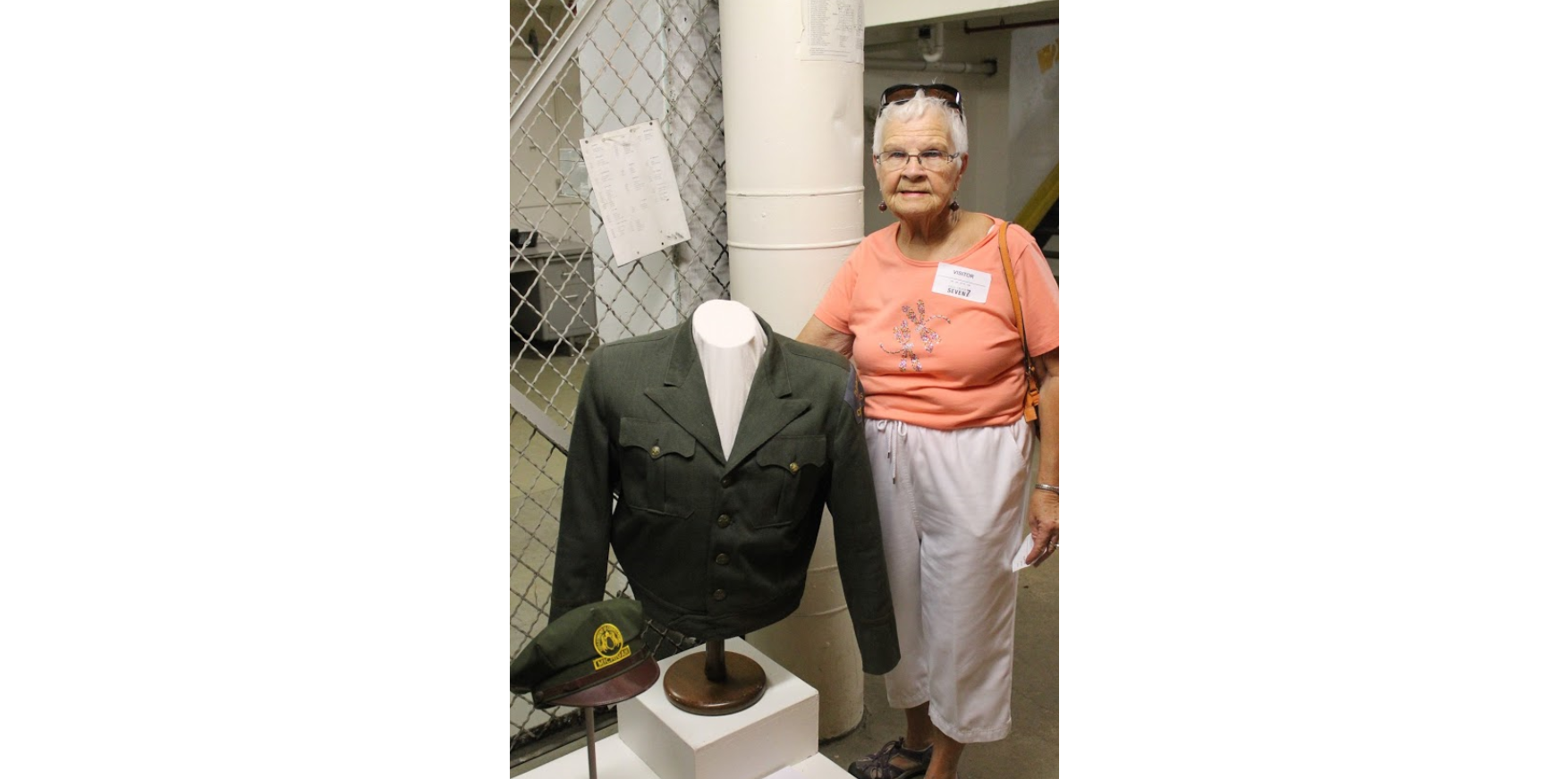
Donna Stephens, the first female prison corrections officer in Michigan
by Judy Williams
What makes a homemaker and mother of five decide to undertake a career as a female corrections officer in a male facility? “Why not?” Donna Kathryn Wilson Stephens is likely reply. In 1969, when her family was mostly grown, Stephens became the State’s first female corrections officer.
Stephens was working at the Jackson State Prison (JSP) in the Medical Records department when she saw an internal job posting for a Woman Correction Officer. “I went through the interview process and was the first officer selected,” the white-haired Stephens stated with a smile. “I was in the right place at the right time.”
Husband George, a corrections officer from Cassidy Lake Correctional Facility, and her children were proud and supportive of her promotion, Stephens said. The kids thought it was especially amazing that the prison administration would teach their mother to shoot a gun.
Stephens received the same training as the male corrections officers, a combination of self-defense, revolver and rifle proficiency, plus rules and regulations for government and corrections. Laughing, Stephens stated, “I got to watch a video on how to shoot a machine gun, but I never got to shoot one.”
Corrections officers are not allowed to carry firearms inside the bars. Firearms were carried at the gate and in the public area inside the prison and turrets.
At first, Stephens wasn’t issued a uniform, but eventually the inmates made uniform jackets and skirts for the women correction officers. Years later, the women officers were allowed to wear slacks.
During the time that Stephens worked as a corrections officer, visitors were allowed to enter the main building area.
“I would stop to see Mom at the prison,” Stephens’ youngest daughter, Beth, added with a twinkle in her eyes, “and have a couple of my girlfriends with me. Later, my friends would ask, ‘Where are the inmates?’ I loved to the look on their faces when I would tell them, ‘You were standing beside them.’” Beth purposefully omitted telling them that the inmates were trustees who had earned the right to work in the visiting area.
“No two days were ever alike,” the petite Stephens stated. “As a corrections officer, I mainly worked at the visitor processing desk. One of my duties was to do body searches on visitors. I found many different forms of contraband, drug, money, etc.” Grinning, Stephens continued her story, “I found contraband in many places from bras, hem linings, hair and children’s clothing. One time a young woman was acting nervous while holding her baby, and I noticed a large bulge in the baby’s socks.” Stephens discovered a bag of phencyclidine, an illegal street drug. “Sadly,” she said, “the baby was taken to Child Protective Service, and the mother was sent to jail.”
“Over the years, I got so I could sense when one might be going to pass something to a prisoner, the feisty Stephens explained. “I would warn the visitor that they could cancel the visit and not be frisked. I couldn’t help myself, I felt that I should give these young visitors a grandmotherly dress down. I didn’t want them to think they were fooling anyone.”
One of Stephen’s more comical stories regarding frisking visitors occurred when a woman turned out to be man. “A parolee came in dressed as a woman because he wanted to see an inmate,” Stephens chuckled. “Parolees are not allowed to visit inmates. I got good at recognizing strange situations. This was definitely a long way from my days on the farm.”
Another peculiar incident occurred when a trustee came to the desk with pink curlers on his head. Stephens giggled. “All I could do was laugh when he couldn’t tell me how he stuck them in.”
“One day while shopping at Fields Department Store with my girls, I spotted an inmate that I had waited on just a few days earlier.” Stephens continued. “I knew him by his inmate number, so I screamed it out when I saw him. I scared my girls, and they hid in the racks of clothes. My mistake,” Stephens confessed. “He had just been paroled.”
Stephens recalled one Nealy Buchanan, convicted of murdering a couple from Millville. “He had on his visitors list his wife and his sister. Turns out that his sister was really his girlfriend. The wife and girlfriend showed up for a visit at the same time. He fainted, so he wouldn’t have to deal with them.”
JSP had famous visitors and inmates during Stephens’ tenure. Billy Graham’s wife visited to counsel an inmate. Also, Stephens encountered famous people as inmates, including the movie star, Tim Allen; former Detroit Tiger, Ron LeFoure; and the Ann Arbor serial killer, John Norman Collins.
Several major events took place during Stephens’ career at JSP. In 1975, guards watched in disbelief as a helicopter landed in the prison yard, and inmate Dale Otto Remling jumped aboard and went airborne in a matter of seconds. The occupants of the helicopter had cars waiting near Michigan106 and Meridian Road. The escapee lingered to spray Mace in the pilot’s face, and in the confusion, missed his ride. After a night of wandering the countryside, Remling ended up in a Leslie bar. There he was apprehended and returned behind bars.
“As soon as I heard who had escaped, I immediately checked the visitor files, Stephens said. “I had processed the girlfriend for a visit the day before. Bingo, the girlfriend was arrested too. Crazy day!”
Another newsworthy, but sad chapter in Stephens’ work history took place during the infamous 1981 Memorial Day weekend riot. The three complexes of the State prison of southern Michigan at Jackson was operating with a skeleton staff. The remainder of the prison’s corrections officers were home as part of a mandatory, payless holiday for state employees. On May 22, two corrections officers were assaulted and seriously injured.
The following day when corrections officers attempted a weapons search, prisoners went on a rampage. A full emergency was declared, and all off-duty guards were called in. During this uprising, most of the damage resulted from fires. The prison was locked down over the weekend, and then once the lockdown was lifted, a second riot started. No fatalities were reported, and no hostages were taken.
“Many inmates with their belongings lined the perimeter fences all day to stay out of the riot and protect their possessions,” Stephens recalled. “There was a massive amount of State Police presence to help. It was eerie.”
Stephens’ worst day as a corrections officer took place March 24, 1987. Rookie officer, Josephine McCallum, was murdered and sexually assaulted, Stephens said. McCallum had been working alone. “Those sirens. They just didn’t stop for the longest time, and when they did stop, the silence overtook the entire room. I knew instantly something really bad had happened.”
“I feel ‘institutional racism’ is chronic in our justice system,” Stephens said thoughtfully. “Blacks, Hispanics, and poor people get longer sentences, probably because of inferior representation. Overcrowding becomes a warehouse. It is dangerous for staff and inmates alike. There are many bad people in prisons. You have to be aware of your surroundings and trust your fellow officers. From day one, my fellow officers were supportive and protective of me. All of them were professional and respectful of each other.”
“I had several negative situations, but nothing like those who work behind the bars,” Stephens said. “Once an inmate grabbed my wrist and tried to pull me over the counter. Mainly there was the verbal abuse that I found more annoying than scary.”
The sprightly lady quickly recovered and added, “I loved my job and did it well, but I wouldn’t be an officer today.”
The most amazing fact about Donna Kathryn Wilson Stephens is she doesn’t understand why anyone would refer to her as remarkable.

Photo credit Linda Stephens



